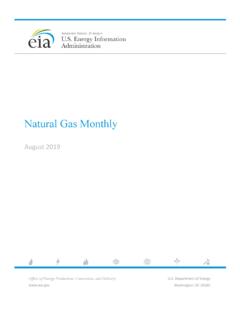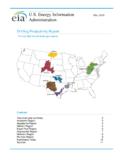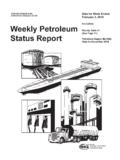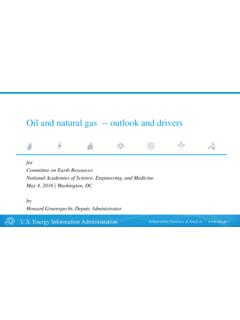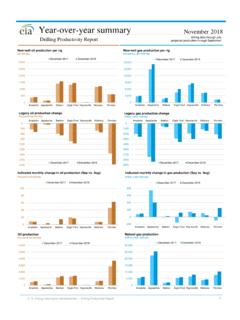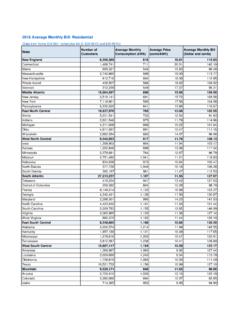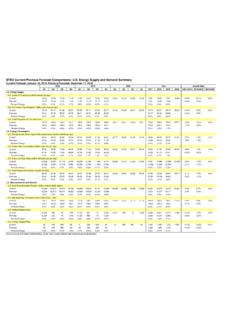Transcription of Review of Emerging Resources: U.S. Shale Gas and Shale Oil ...
1 Shale Gas and Shale Oil PlaysReview of Emerging Resources: July Department of EnergyWashington, DC 20585 This page inTenTionally lefT blankThe information presented in this overview is based on the report Review of Emerging Resources: Shale Gas and Shale Oil Plays, which was prepared by INTEK, Inc. for the Energy Information Administration (EIA), the statistical and analytical agency within the Department of Energy. The full report is attached. By law, EIA s data, analyses, and forecasts are independent of approval by any other officer or employee of the United States Government. The views in this report therefore should not be construed as representing those of the Department of Energy or other Federal Energy Information Administration | Review of Emerging Resources: Shale Gas and Shale Oil Plays4 Review of Emerging Resources: Shale Gas and Shale Oil PlaysBackgroundThe use of horizontal drilling in conjunction with hydraulic fracturing has greatly expanded the ability of producers to profitably recover natural gas and oil from low-permeability geologic plays particularly, Shale plays.
2 Application of fracturing techniques to stimulate oil and gas production began to grow rapidly in the 1950s, although experimentation dates back to the 19th century. Starting in the mid-1970s, a partnership of private operators, the Department of Energy (DOE) and predecessor agencies, and the Gas Research Institute (GRI) endeavored to develop technologies for the commercial production of natural gas from the relatively shallow Devonian (Huron) Shale in the eastern United States. This partnership helped foster technologies that eventually became crucial to the production of natural gas from Shale rock, including horizontal wells, multi-stage fracturing, and slick-water Practical application of horizontal drilling to oil production began in the early 1980s, by which time the advent of improved downhole drilling motors and the invention of other necessary supporting equipment, materials, and technologies (particularly, downhole telemetry equipment) had brought some applications within the realm of commercial viability.
3 2 The advent of large-scale Shale gas production did not occur until Mitchell Energy and Development Corporation experimented during the 1980s and 1990s to make deep Shale gas production a commercial reality in the Barnett Shale in North-Central Texas. As the success of Mitchell Energy and Development became apparent, other companies aggressively entered the play, so that by 2005, the Barnett Shale alone was producing nearly trillion cubic feet of natural gas per year. As producers gained confidence in the ability to produce natural gas profitably in the Barnett Shale , with confirmation provided by results from the Fayetteville Shale in Arkansas, they began pursuing other Shale plays, including Haynesville, Marcellus, Woodford, Eagle Ford, and the Energy Information Administration s (EIA) National Energy Modeling System (NEMS) and energy projections began representing Shale gas resource development and production in the mid-1990s, only in the past 5 years has Shale gas been recognized as a game changer for the natural gas market.
4 The proliferation of activity into new Shale plays has increased dry Shale gas production in the United States from trillion cubic feet in 2006 to trillion cubic feet, or 23 percent of total dry natural gas production, in 2010. Wet Shale gas reserves increased to about trillion cubic feet by year-end 2009, when they comprised about 21 percent of overall natural gas reserves, now at the highest level since Oil production from Shale plays, notably the Bakken Shale in North Dakota and Montana, has also grown rapidly in recent years. To gain a better understanding of the potential domestic Shale gas and Shale oil resources, EIA commissioned INTEK, Inc. to develop an assessment of onshore Lower 48 States technically recoverable Shale gas and Shale oil resources. This paper briefly describes the scope, methodology, and key results of the report and discusses the key assumptions that underlie the results.
5 The full report prepared by INTEK is provided in Attachment A. The Shale gas and Shale oil resource assessment contained in the INTEK report and summarized here was incorporated into the Onshore Lower 48 Oil and Gas Supply Submodule (OLOGSS) within the Oil and Gas Supply Module (OGSM) of NEMS to project oil and natural gas production for the Annual Energy Outlook 2011 (AEO2011).EIA also anticipates using the assessment to inform other analyses and to provide a starting point for future and resultsThe INTEK Shale resources report estimates Shale gas and Shale oil resources for the undeveloped portions of 20 Shale plays that have been discovered (Table 1). Eight of those Shale plays are subdivided into 2 or 3 areas, resulting in a total of 29 separate resource assessments. The total of 750 trillion cubic feet shown in Table 1 excludes three additional components of resources: proven reserves, inferred reserves in actively developed areas and un-discovered resources as estimated by the Geological Survey (USGS).
6 The map in Figure 1 shows the location of the Shale plays in the Lower 48 States. Eighty-six percent of the total 750 trillion cubic feet of technically recoverable Shale gas resources identified in Table 1 are located in the Northeast, Gulf Coast, and Southwest regions, which account for 63 percent, 13 percent, and 10 percent of the total, respectively. In the three regions, the largest Shale gas plays are the Marcellus ( trillion cubic feet, 55 percent of the total), Haynesville ( trillion cubic feet, 10 percent of the total), and Barnett ( trillion cubic feet, 6 percent of the total).Table 1 also summarizes the INTEK Shale report s assessment of technically recoverable Shale oil resources, which amount to billion barrels in the onshore Lower 48 States. The largest Shale oil formation is the Monterey/Santos play in southern California, which is estimated to hold billion barrels or 64 percent of the total Shale oil resources shown in Table 1.
7 The Monterey Shale play is the primary source rock for the conventional oil reservoirs found in the Santa Maria and San Joaquin Basins in southern California. The next largest Shale oil plays are the Bakken and Eagle Ford, which are assessed to hold approximately billion barrels and billion barrels of oil, Energy Information Administration | Review of Emerging Resources: Shale Gas and Shale Oil Plays Review of Emerging Resources: Shale Gas and Shale Oil PlaysThe 750 trillion cubic feet of Shale gas resources in the INTEK Shale report is a subset of the AEO2011 onshore Lower 48 States natural gas Shale technically recoverable resource estimate of 862 trillion cubic feet. The AEO2011 includes 35 trillion cubic feet of proved reserves reported to the Securities and Exchange Commission (SEC) and the EIA, 20 trillion cubic feet of inferred reserves not included in the INTEK Shale report, and 56 trillion cubic feet of undiscovered resources estimated by the 1.
8 INTEK estimates of undeveloped technically recoverable Shale gas and Shale oilresources remaining in discovered Shale plays as of January 1, 2009 Onshore Lower-48 Oil and Gas SupplySubmodule regionShale playShale gas resources(trillion cubic feet) Shale oil resources(billion barrels)NortheastMarcellus410--Antrim20- -Devonian Low Thermal Maturity14 New Albany11--Greater Siltstone8--Big Sandy7--Cincinnati Arch*1--Subtotal472--Percent of total63%--Gulf CoastHaynesville75--Eagle Ford213 Floyd-Neal & Conasauga4--Subtotal1003 Percent of total13%14%Mid-ContinentFayetteville32-- Woodford22--Cana Woodford6--Subtotal60--Percent of total8%--SouthwestBarnett43--Barnett-Woo dford32--Avalon & Bone Springs--2 Subtotal762 Percent of total10%7%Rocky MountainMancos21--Lewis12--Williston-Sha llow Niobraran*7--Hilliard-Baxter-Mancos4--Ba kken--4 Subtotal434 Percent of total6%15%West CoastMonterey/Santos--15 Subtotal--15 Percent of total--64%Total onshore Lower-48 States75024*Note.
9 From previous EIA estimates and thus not assessed in the INTEK Shale and total may not equal sum of components due to independent Energy Information Administration | Review of Emerging Resources: Shale Gas and Shale Oil Plays6 Review of Emerging Resources: Shale Gas and Shale Oil PlaysFigure 1. Map of Shale gas and Shale oil plays (as of May 9, 2011)Source Energy Information Administration based on data from various published : May 9, 2011 MethodologyThe resource estimates shown in Table 1 were developed by INTEK from publicly available company data and commercial databases for wells and acreage currently in production. The estimates of technically recoverable resources shown in Table 1 are based on the area, well spacing, and average expected ultimate recovery (EUR) for each Shale play or subportion of the play.
10 An effective recovery factor has been applied which reflects: (a) a probability factor that takes into account the results from current Shale gas activity as an indicator of how much is known or unknown about the Shale play; (b) a recovery factor that takes into account prior experience in how production occurs, on average, given a range of factors (including mineralogy and geologic complexity) that affect the response of the geologic play to the application of best-practice Shale gas recovery technology; and (c) resources in the play that have already been produced or added into proved of technically recoverable Shale gas resources are certain to change over time as new wells go into production and new technologies are developed. For example, the gas resource estimates in the INTEK Shale report are predicated on the assumption that natural gas production rates for current wells covering only a limited portion of a play are representative of an entire play or play sub-area; however, across a single play or play sub-area there can be significant variations in depth, thickness, porosity, carbon content, pore pressure, clay content, thermal maturity, and water content.

